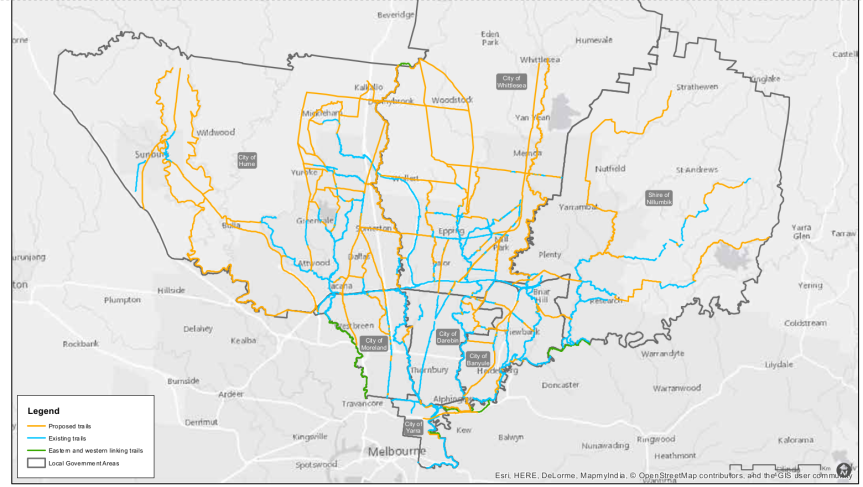
This is a brief exercise on Benefit Management
According to the Northern Region Bicycle Trail Network strategy (2016)(1) (Interactive Map) it would cost $162 million to develop and construct 480 kilometres of new bike paths in the northern region of Melbourne.
For a 3 metre path the estimate is a benefit-cost ratio of 0.9 for 1 year and 9.9 for the 30 year period.
So the economic and social benefits would outweigh the construction costs in little over a year after completion, and those benefits would continue to add up after that contributing to improved liveability in the northern suburbs.
Over the expected minimum lifetime for the paths of 30 years the benefits would be near 10 times the cost and maintenance.
Construction would also contribute 650 full time equivalent (FTE) jobs as part of the project.
Yet cycling in the Victorian State Transport Infrastructure budget is given very small amounts of money – in 2018 it was about $23 million or 0.36 percent of total transport infrastructure funding.
In 2019 direct funding of cycling as part of transport infrastructure investment in the budget was even lower. Of $46.9 billion funded, the proportion allocated was:
- Roads 68.9 per cent;
- public transport 28.6 per cent (including level crossing removal);
- road safety, boating, a new St Kilda pier, Carrum promenade revitalisation 2.3 per cent;
- and Cycling just 0.175 per cent.
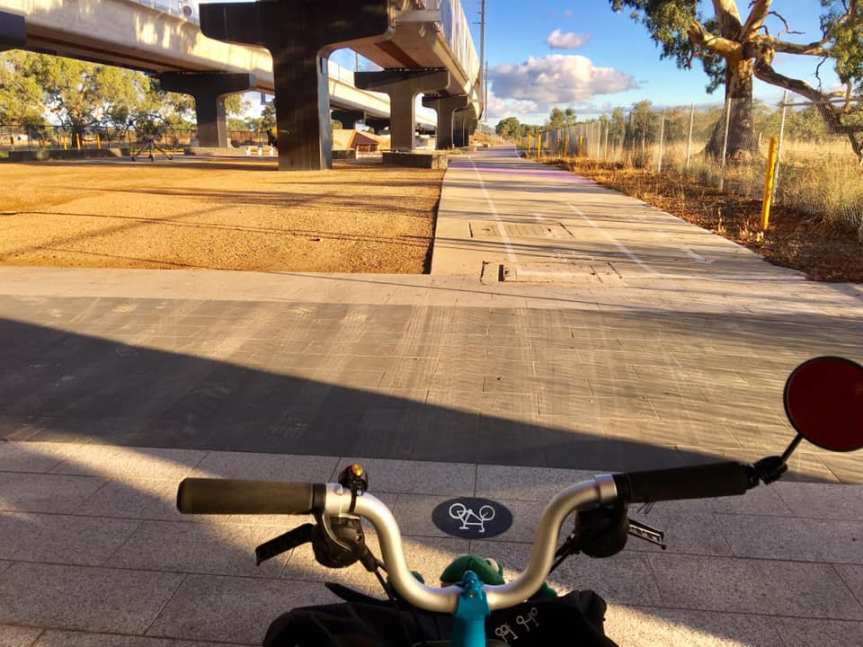
For non-transport cycling funding, the Andrews Government made an election commitment in November 2018 to improve Melbourne parkland and reserves. This included in Melbourne’s north and north-eastern suburbs (see Bicycle Network report on this).
These election commitments included:
* create a new 2,778 hectare Upper Merri Park, near Craigieburn
* expand the Quarry Hills Parkland to cover 1,088 hectares, near South Morang
* complete the Plenty River Trail, building another 17 kilometres of walking and cycling trail stretching from Mernda to the Western Ring Road at Greensborough
* invest in new bike and walking trails across Nillumbik, Moreland, Banyule, Darebin, Hume and Whittlesea council areas
* undertake a feasibility study for a new Wallan Regional Park
Bicycle Network advocates that the Victorian Government should Establish a $129 million+ annual bike fund, “to deliver a bicycle network that closes the gaps and matches the demands and abilities of Victorians who are riding or want to.”
According to Bicycle Network funding cycling infrastructure at this level is the equivalent of investing $20 per person, per year.
Northern Trails strategy announced in 2016
The Northern Trails strategy was developed and planned over four years by northern region Councils with a grant of $50,000 from the Labor State Government. It brings together 120 existing off-road trails and 96 proposed new trails. In total, the network will span 780 kilometres throughout seven municipalities (300 km existing path network, 480km new paths)
The strategy integrates off-road bike and walking paths through Banyule, Whittlesea, Darebin, Yarra, Hume, Moreland and Nillumbik.
At the time of the launch of this strategy Minister for Sport John Eren said in the media release “This trails strategy will motivate more Victorians to pedal their way to a healthy and active lifestyle. Melbourne’s north is a great place to get outside and enjoy the outdoors.”
“Trails aren’t just a great place to exercise, they’re an important driver of local economies. They attract visitors from all over the state.”
“New trails will provide cyclists, walkers and runners with a safe, vehicle-free way to get healthy.” said John Eren.
Large areas of the northern suburbs has poor public transport, according to Infrastructure Victoria(2), which encourages high car dependency. This effects long term health outcomes for fitness, obesity and preventable chronic
Health statistics show that 63 per cent of Australian adults and 25 per cent of kids are overweight or obese. Cycling, walking and running are just some of the keys to a healthier lifestyle.
Building more bicycle paths and trails will increase take up of active transport for recreational and commuter use, that will improve health outcomes and reduce obesity in outer urban communities of Melbourne’s north.(3)
The Labor Government Our Safer Cyclists and Pedestrians Fund provided $100 million over a four year period, approximating to about $25 million of new active transport infrastructure funding per year. While this is positive it falls well short of what is required in building the infrastructure that keeps cyclists and pedestrians safer on our roads.
Trails Strategy promotional video from August 2016:
Benefit metrics
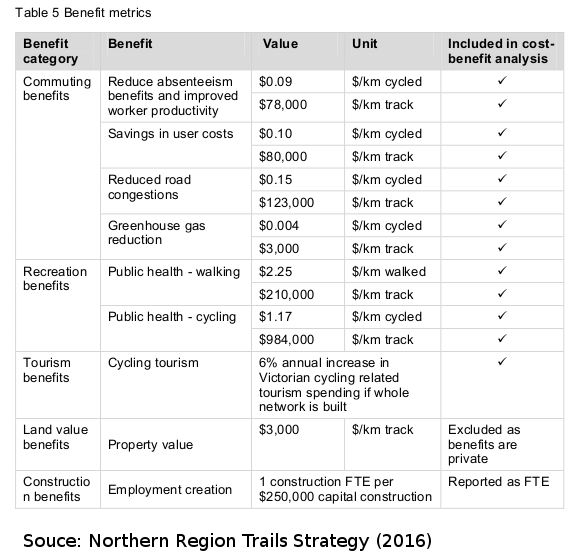
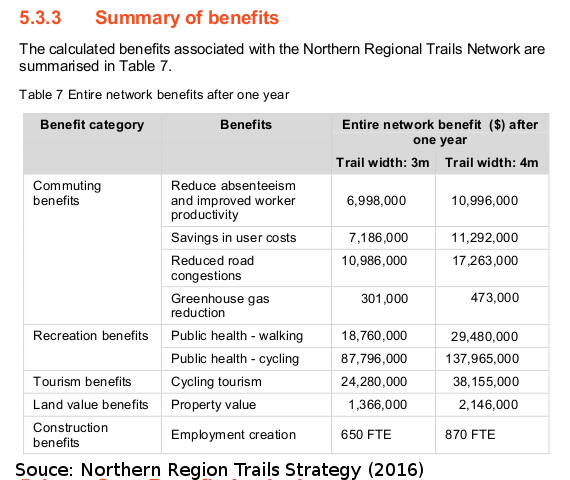
Total Cost, benefits and benefit-cost ratio
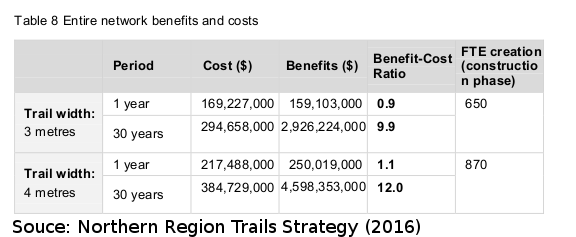
So what are the approximate costs in path construction per kilometre?
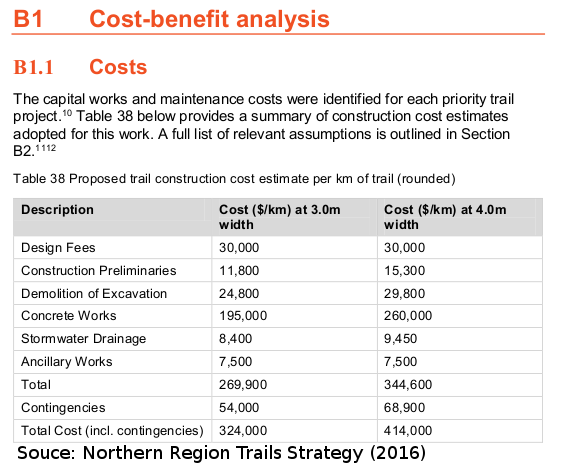
Notes:
(1) Northern Region Trails Strategy (2016) https://www.nillumbik.vic.gov.au/files/assets/public/council/council-publications/strategies-etc/northern-regional-trails-strategy.pdf
(2) Infrastructure Victoria, April 2019 – SGS – Economic, social and environmental profile Northern Metro Region – April 2019 http://www.infrastructurevictoria.com.au/wp-content/uploads/2019/04/SGS-Economic-social-and-environmental-profile-Northern-Metro-Region-April-2019.pdf
(3) Obesity-related health impacts of active transport policies in Australia – a policy review and health impact modelling study, Brown, Vicki, Moodie, Marj, Cobiac, Linda, Mantilla, Herrera and Carter, Robert 2017, Obesity-related health impacts of active transport policies in Australia – a policy review and health impact modelling study, Australian and New Zealand journal of public health, vol. 41, no. 6, pp. 611-616, doi: 10.1111/1753-6405.12726.
